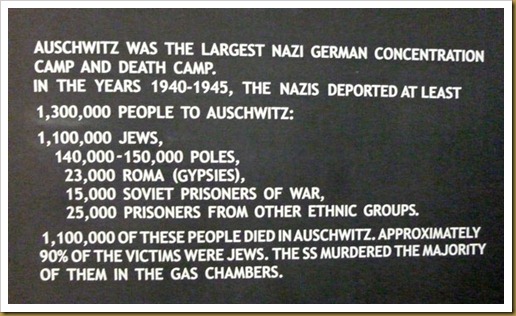Four weeks later we are home and healthy again. It was a wonderful trip with Dresden, Prague and Krakow among the highlights. The first video (approx. 14 min.) has pictures of our time in Hamburg, the Elbe River Cruise, and Prague. The next slideshow (approx. 5 min.) highlights our time in Poland. During the trip I took some videos of the astronomical clocks, street music, and the Chopin concert in Warsaw which can be found on the final video (approx. 8 min.).
The Elbe River & Poland
Monday, October 3, 2011
Tuesday, September 6, 2011
Day 17 ~ Warsaw
Warsaw is the capital and largest city of Poland. As of June 2010, its population was estimated at 1,716,855, with the metropolitan area at approximately 2,631,902, making it the 9th largest city in the European Union.
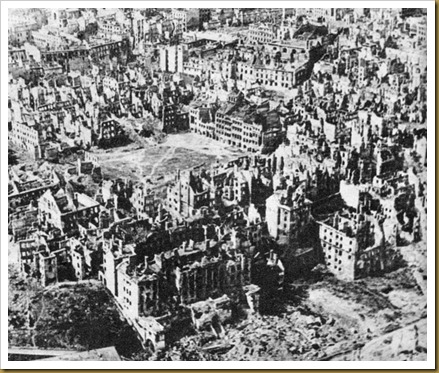 About 85% of the city was destroyed by the Germans in WW II, including the historic Old Town and the Royal Castle. This is Warsaw January 1, 1945 (thanks, once again, to the Internet for the photo).
About 85% of the city was destroyed by the Germans in WW II, including the historic Old Town and the Royal Castle. This is Warsaw January 1, 1945 (thanks, once again, to the Internet for the photo).
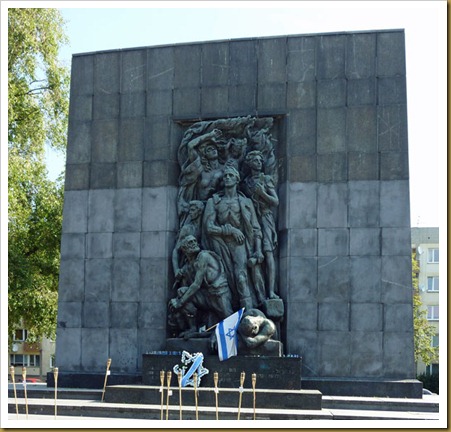 Before the outbreak of World War II, the northwestern part of Warsaw was mostly occupied by the Jewish population (about 400,000 people, some 30% of the city). During the World War II a ghetto was formed out of the Jewish district by the Germans. When the order came to annihilate the ghetto as part of Hitler's "Final Solution" on 19 April 1943, Jewish fighters launched the Warsaw Ghetto Uprising. Despite being heavily outgunned and outnumbered, the Ghetto held out for almost a month. When the fighting ended, almost all survivors were massacred; only few managed to escape or hide. The above memorial commemorates the brave Jews who fought during the ghetto uprising.
Before the outbreak of World War II, the northwestern part of Warsaw was mostly occupied by the Jewish population (about 400,000 people, some 30% of the city). During the World War II a ghetto was formed out of the Jewish district by the Germans. When the order came to annihilate the ghetto as part of Hitler's "Final Solution" on 19 April 1943, Jewish fighters launched the Warsaw Ghetto Uprising. Despite being heavily outgunned and outnumbered, the Ghetto held out for almost a month. When the fighting ended, almost all survivors were massacred; only few managed to escape or hide. The above memorial commemorates the brave Jews who fought during the ghetto uprising.
 After the war, the conquering Soviets constructed this building, originally known as the Joseph Stalin Palace of Culture and Science. Its architecture is closely related to several similar skyscrapers built in the Soviet Union of the same era. Many Poles initially hated the building because they considered it to be a symbol of Soviet domination. Even with other modern sky scrapers, the Palace of Culture and Science is the dominant structure in Warsaw. The Soviets also erected large prefabricated housing projects in Warsaw to address the housing shortage. Poland regained its independence from the Soviets in 1989.
After the war, the conquering Soviets constructed this building, originally known as the Joseph Stalin Palace of Culture and Science. Its architecture is closely related to several similar skyscrapers built in the Soviet Union of the same era. Many Poles initially hated the building because they considered it to be a symbol of Soviet domination. Even with other modern sky scrapers, the Palace of Culture and Science is the dominant structure in Warsaw. The Soviets also erected large prefabricated housing projects in Warsaw to address the housing shortage. Poland regained its independence from the Soviets in 1989.
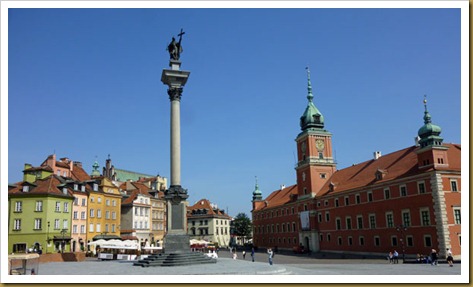 Many of the historic streets, buildings, and churches were restored to their original form. Above is the reconstructed Royal Castle and the beginning of the Old Town. In 1980, this area was registered as a UNESCO World Heritage Site.
Many of the historic streets, buildings, and churches were restored to their original form. Above is the reconstructed Royal Castle and the beginning of the Old Town. In 1980, this area was registered as a UNESCO World Heritage Site.
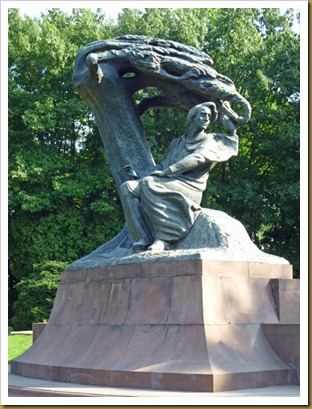 The Polish people are very proud of their native son, composer Frédéric Chopin. The above sculpture was destroyed by the Germans in 1940, but rebuilt in 1958.
The Polish people are very proud of their native son, composer Frédéric Chopin. The above sculpture was destroyed by the Germans in 1940, but rebuilt in 1958.
 The Presidential Palace survived the war, and today it functions as seat of the Polish Council of Ministers.
The Presidential Palace survived the war, and today it functions as seat of the Polish Council of Ministers.
After about 6 hours of touring and walking around Warsaw, it was time to begin packing for home. Our travel group had a farewell drink at 5:30; then Bonnie, Liisa, Ruth, and I had a quiet dinner in the hotel. They saved the best hotel for last. Although all our rooms were pleasant on this trip, we loved our room at the Sheraton.
Monday, September 5, 2011
Day 16 ~ On the road to Warsaw
We left Krakow this morning at 8:00 am. After several stops, we finally reached Warsaw around 5:30 pm. Below are some of our adventures for today.
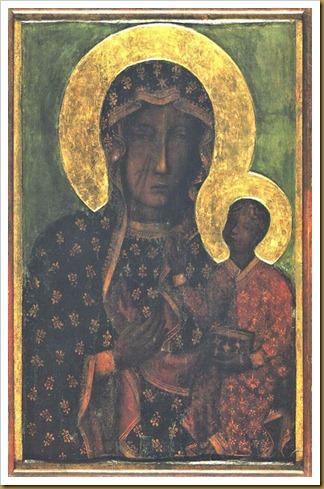 Our first stop was the Jasna Góra Monastery founded in 1382 by Pauline monks who came from Hungary. It is the most famous shrine to the Virgin Mary in Poland and the country's greatest place of pilgrimage. The image of Black Madonna of Częstochowa, to which miraculous powers are attributed, is Jasna Góra's most precious treasure. Because today is Sunday, the area was wall to wall people. I did get a quick peek of the Madonna and a picture, but the picture above that I found on the internet was much better.
Our first stop was the Jasna Góra Monastery founded in 1382 by Pauline monks who came from Hungary. It is the most famous shrine to the Virgin Mary in Poland and the country's greatest place of pilgrimage. The image of Black Madonna of Częstochowa, to which miraculous powers are attributed, is Jasna Góra's most precious treasure. Because today is Sunday, the area was wall to wall people. I did get a quick peek of the Madonna and a picture, but the picture above that I found on the internet was much better.
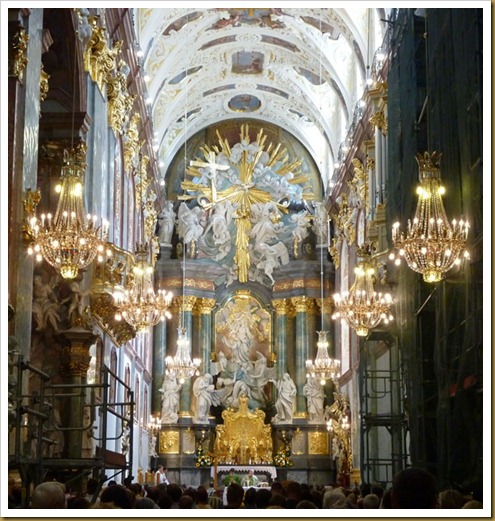 The main nave of the basilica is the most ornate church I have ever seen.
The main nave of the basilica is the most ornate church I have ever seen.
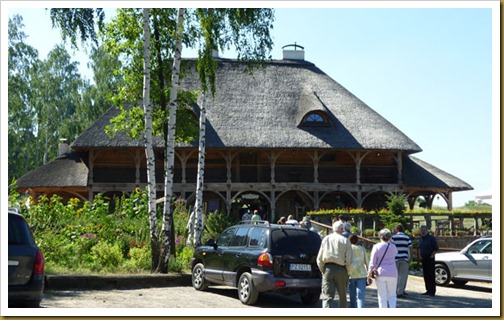 For lunch, we stopped at Spichlerz Restaurant not far from the monastery. This example of polish folkloristic wooden architecture was built in 1783 and had a beautiful thatched roof.
For lunch, we stopped at Spichlerz Restaurant not far from the monastery. This example of polish folkloristic wooden architecture was built in 1783 and had a beautiful thatched roof.
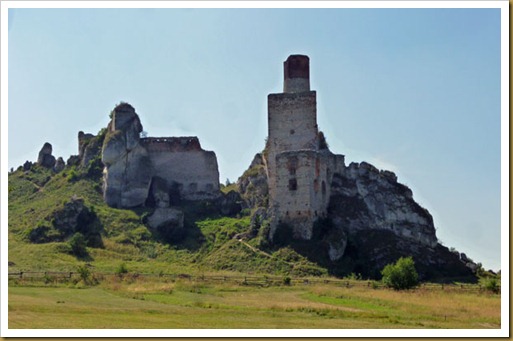 The restaurant was located at the foot of the castle ruins from XIV century.
The restaurant was located at the foot of the castle ruins from XIV century.
 Right after we arrived in Warsaw, we quickly got ready for our Chopin recital. Twenty-three of us attended the private recital in the Szuster Palace, built in 1774. Here, the four of us are enjoying a little bubbly during the intermission.
Right after we arrived in Warsaw, we quickly got ready for our Chopin recital. Twenty-three of us attended the private recital in the Szuster Palace, built in 1774. Here, the four of us are enjoying a little bubbly during the intermission.
 After the concert, we all went out to dinner. Bonnie’s birthday will be in a few days so she was treated to fireworks on her desert. A Polish family next to us was celebrating the christening of their new son. The happy father got up and led his group in singing happy birthday to Bonnie in Polish. He then gave us a shot of Vodka and kissed our hands. What a fun way to end our evening!
After the concert, we all went out to dinner. Bonnie’s birthday will be in a few days so she was treated to fireworks on her desert. A Polish family next to us was celebrating the christening of their new son. The happy father got up and led his group in singing happy birthday to Bonnie in Polish. He then gave us a shot of Vodka and kissed our hands. What a fun way to end our evening!
Saturday, September 3, 2011
Day 15 ~ Krakow ~ Auschwitz-Birkenau
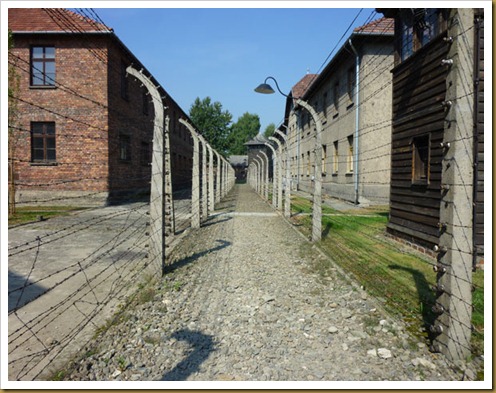 Above is the electric double fence surrounding Auschwitz I concentration camp. Containing 28 buildings, the camp eventually ran out of room and Auschwitz II–Birkenau was built.
Above is the electric double fence surrounding Auschwitz I concentration camp. Containing 28 buildings, the camp eventually ran out of room and Auschwitz II–Birkenau was built.
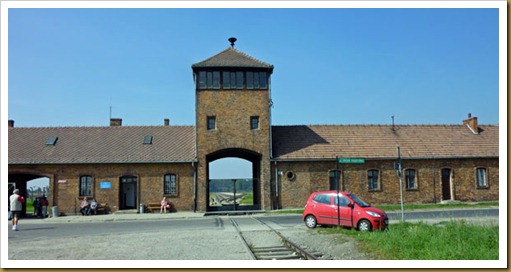 This is the main gate into Auschwitz II–Birkenau. This complex contained over 300 buildings and was about 1 square mile. Many of the brick building were built by reusing the bricks from the Polish towns demolished by the Third Reich. Birkenau primarily functioned as an extermination camp in the context of Heinrich Himmler's preparations for the Final Solution of the Jewish Question, the extermination of the Jews.
This is the main gate into Auschwitz II–Birkenau. This complex contained over 300 buildings and was about 1 square mile. Many of the brick building were built by reusing the bricks from the Polish towns demolished by the Third Reich. Birkenau primarily functioned as an extermination camp in the context of Heinrich Himmler's preparations for the Final Solution of the Jewish Question, the extermination of the Jews.
 The wooden barracks would house up to 1000 prisoners. The camp inmates were plagued by lack of water, terrible sanitary conditions, and huge number of rats.
The wooden barracks would house up to 1000 prisoners. The camp inmates were plagued by lack of water, terrible sanitary conditions, and huge number of rats.
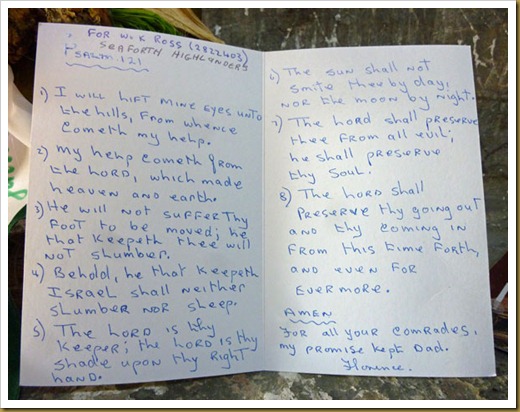 Inside this barrack on the chimney, there was a small memorial with the above note. It was very difficult not to become emotional when reading the final lines.
Inside this barrack on the chimney, there was a small memorial with the above note. It was very difficult not to become emotional when reading the final lines.
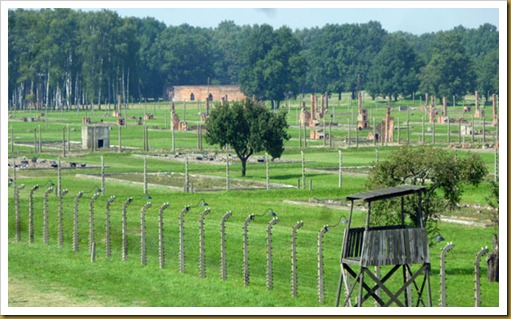 The brick building in a distance is what remains of one of the four gas chambers and crematoriums. In the foreground, you can see many brick chimneys, the only remains of the wooden barracks.
The brick building in a distance is what remains of one of the four gas chambers and crematoriums. In the foreground, you can see many brick chimneys, the only remains of the wooden barracks.
Bonnie didn’t join me on today’s excursion due to the fact that Auschwitz is such a difficult place to see. Hoping we can regain some energy for our last few days in Poland, we are both taking it easy tonight and staying in.
Day 14 ~ Krakow
Kraków, once the capital of Poland, is the second largest city. Situated on the Vistula River, the city dates back to the 7th century. Kraków has traditionally been one of the leading centers of Polish academic, cultural, and artistic life and is one of Poland's most important economic hubs. In the Middle Ages, it was one of the biggest and richest trade centers. The city has a population of approximately 760,000, but about 8 million people live within a 100 km radius of its main square.
After the invasion of Poland by Nazi Germany at the start of World War II, Kraków was turned into the capital of Germany's General Government. This is the reason the the city was not destroyed like other Polish cities. The Jewish population of the city was moved into a walled zone known as the Kraków Ghetto from which they were sent to extermination camps such as Auschwitz and the concentration camp at Płaszów.
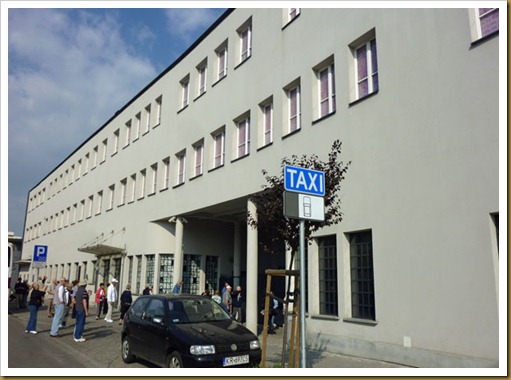 Oskar Schindler initially employed Krakow Jews as cheap labor in his enamelware and ammunitions factory. When he witnessed the “liquidation” action conducted in the ghetto by the Nazis, he tried to save the Jews he employed. At the end of the war, Schindler managed to save approximately 1,200 of his employees by transferring them to his factory in Czechoslovakia.
Oskar Schindler initially employed Krakow Jews as cheap labor in his enamelware and ammunitions factory. When he witnessed the “liquidation” action conducted in the ghetto by the Nazis, he tried to save the Jews he employed. At the end of the war, Schindler managed to save approximately 1,200 of his employees by transferring them to his factory in Czechoslovakia.
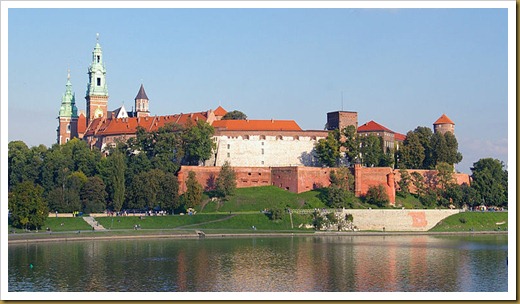 Wawel is an architectural complex erected over many centuries atop a limestone outcrop on the left bank of the Vistula River. The Royal Castle with an armory and the Cathedral are situated on the hill.
Wawel is an architectural complex erected over many centuries atop a limestone outcrop on the left bank of the Vistula River. The Royal Castle with an armory and the Cathedral are situated on the hill.
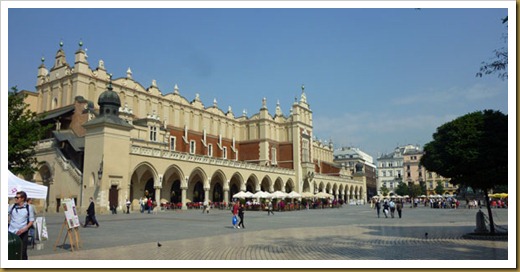 The Main Market Square is the most important market square of the Old Town in Kraków. It dates back to the 13th century and is the largest medieval town square in Europe.
The Main Market Square is the most important market square of the Old Town in Kraków. It dates back to the 13th century and is the largest medieval town square in Europe.
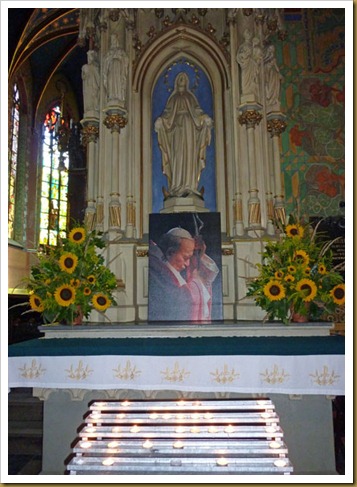 Krakow’s abundance of magnificent churches, monasteries, and convents earned the city a reputation of “the Northern Rome” in the past. Before Pope John Paul II became pope, the Basilica of St. Francis (built 1237-1269) was his home church. Poland is almost 90% Catholic.
Krakow’s abundance of magnificent churches, monasteries, and convents earned the city a reputation of “the Northern Rome” in the past. Before Pope John Paul II became pope, the Basilica of St. Francis (built 1237-1269) was his home church. Poland is almost 90% Catholic.
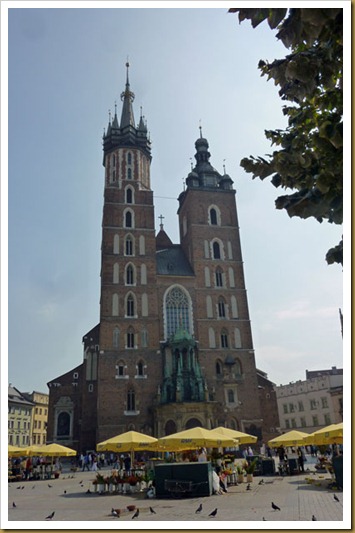 St. Mary's Basilica is a Brick Gothic church re-built in the 14th century (originally built in the early 13th century) adjacent to the Main Market Square. On every hour, a trumpet signal is played from the top of the taller of St. Mary's two towers. The plaintive tune breaks off in mid-stream to commemorate the famous 13th century trumpeter who was shot in the throat while sounding the alarm before the Mongol attack on the city.
St. Mary's Basilica is a Brick Gothic church re-built in the 14th century (originally built in the early 13th century) adjacent to the Main Market Square. On every hour, a trumpet signal is played from the top of the taller of St. Mary's two towers. The plaintive tune breaks off in mid-stream to commemorate the famous 13th century trumpeter who was shot in the throat while sounding the alarm before the Mongol attack on the city.
Wieliczka Salt Mine
The Wieliczka Salt Mine continuously produced table salt from the 13th century until 2007 as one of the world's oldest operating salt mines. The mine's attractions for tourists include dozens of statues and an entire chapel that has been carved out of the rock salt by the miners. About 1.2 million people visit the Wieliczka Salt Mine annually.
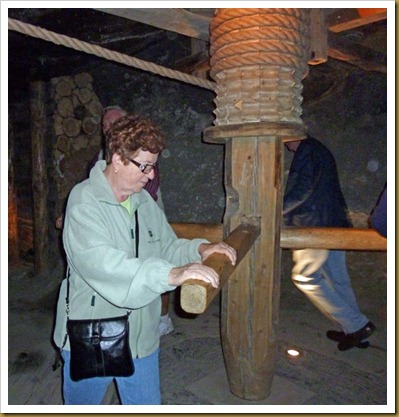 There are many displays depicting the early mining of salt. Here, Bonnie is joined by others in our tour group managing a pulley system.
There are many displays depicting the early mining of salt. Here, Bonnie is joined by others in our tour group managing a pulley system.
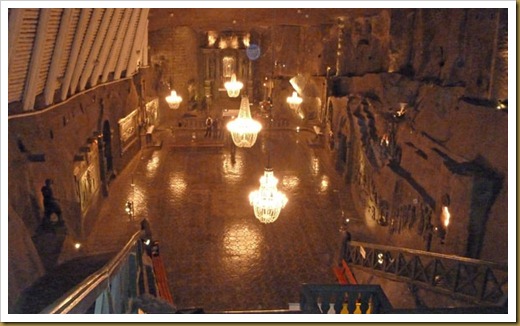 No picture can do justice to the magnificent St. Kinga’s Chapel. The chandeliers, floor, altar, statues and carvings into the wall are all made of salt.
No picture can do justice to the magnificent St. Kinga’s Chapel. The chandeliers, floor, altar, statues and carvings into the wall are all made of salt.
We finished our day with a traditional Polish dinner outside the salt mine. From start to finish, we had a very full day. Bonnie and I continue to fight our colds, but we haven’t let it hold us back so far.
Thursday, September 1, 2011
Day 13 ~ Bus Ride to Krakow
This morning we were up early to get our luggage out, eat breakfast, and load our bus by 8:00 am. We didn’t arrive in Krakow until 6:00 pm this evening. The ride was pleasant with a one potty stop and a two hour lunch break in the town of Olomouc not far from the Polish boarder. A word about the restrooms in Eastern Europe… In most cases, it costs about 50 cents to use the bathroom. The advantage, all the restrooms have been so clean. Actually, the buildings, the sidewalks, the streets, and the country side all are clean and well maintained. Below are a few pictures of our visit in Olomouc.
 The city is located on the Morava River in the eastern part of the Czech Republic. The town hall above, completed in the 15th century, is now a museum.
The city is located on the Morava River in the eastern part of the Czech Republic. The town hall above, completed in the 15th century, is now a museum.
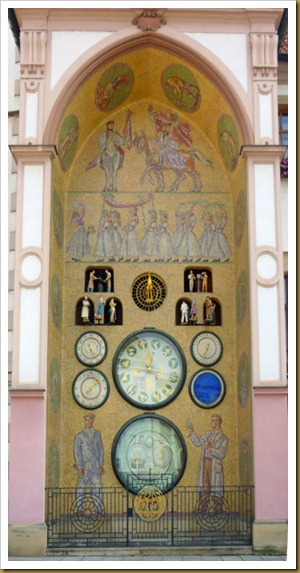 The astronomical clock is a main feature in the town hall. Dating originally from 1420, the clock was remodeled approximately once every century. When the retreating Nazi German army passed through Olomouc in the final days of the war in May, 1945, they opened fire on the old astronomical clock leaving only a few pieces. As a result of the serious damage, the clock was reconstructed in the style of socialist-realism in the first years of communist rule in Czechoslovakia. The religious and royal figures were replaced with athletes, workers, farmers, scientists and other members of the proletariat.
The astronomical clock is a main feature in the town hall. Dating originally from 1420, the clock was remodeled approximately once every century. When the retreating Nazi German army passed through Olomouc in the final days of the war in May, 1945, they opened fire on the old astronomical clock leaving only a few pieces. As a result of the serious damage, the clock was reconstructed in the style of socialist-realism in the first years of communist rule in Czechoslovakia. The religious and royal figures were replaced with athletes, workers, farmers, scientists and other members of the proletariat.
 The Holy Trinity Column in Olomouc is a Baroque monument built in 1716–1754 . This Catholic monument was built partly to show gratitude for ending a plague, which struck Olomouc area between 1714 and 1716. It is the biggest Baroque sculptural group in the Czech Republic.
The Holy Trinity Column in Olomouc is a Baroque monument built in 1716–1754 . This Catholic monument was built partly to show gratitude for ending a plague, which struck Olomouc area between 1714 and 1716. It is the biggest Baroque sculptural group in the Czech Republic.
Because of our big lunch, we just bought some cheese and bread for an evening snack. Bonnie’s cold still is hanging on, and this morning I seem to have succumbed to the bug myself so we are taking it easy when we can.
Day 12 ~ Prague
Prague is the capital and largest city of the Czech Republic. The city is home to about 1.3 million people, while its metropolitan area is estimated to have a population of over 2.3 million. Prague has been a political, cultural and economic center of Europe and particularly central Europe during its 1,100 year existence.
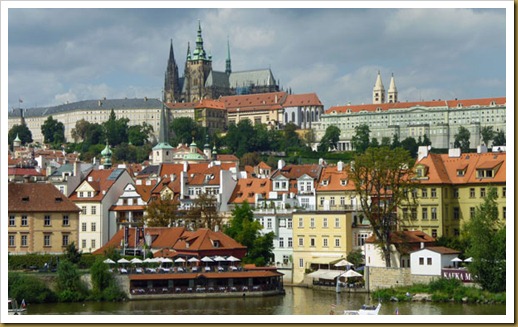 This is a view of the Prague Castle as seen from the Charles Bridge. Construction on the bridge started in 1357 under the auspices of King Charles IV and finished in the beginning of the 15th century. As the only means of crossing the River Vltava until 1841, the Charles Bridge was the most important connection between Prague Castle and the city's Old Town.
This is a view of the Prague Castle as seen from the Charles Bridge. Construction on the bridge started in 1357 under the auspices of King Charles IV and finished in the beginning of the 15th century. As the only means of crossing the River Vltava until 1841, the Charles Bridge was the most important connection between Prague Castle and the city's Old Town.
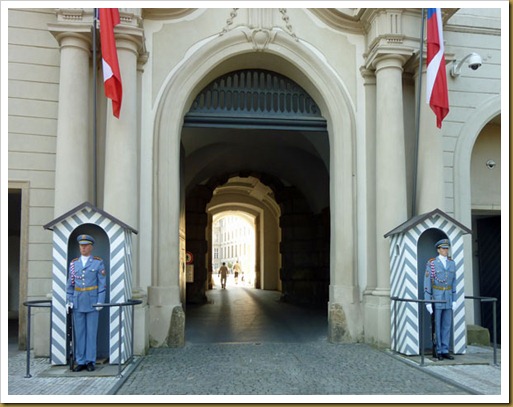 Guards like these are found at each entrance of the Prague Castle. If you didn’t look closely, you would swear they were wax figures.
Guards like these are found at each entrance of the Prague Castle. If you didn’t look closely, you would swear they were wax figures. 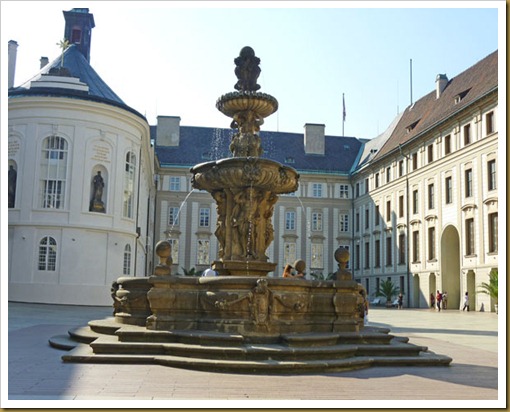 This is a fountain inside one of the three court yards in the castle. Prague Castle is where the Kings of Bohemia, Holy Roman Emperors and presidents of Czechoslovakia and the Czech Republic have had their offices. According to Guinness Book of Records, Prague Castle is the biggest castle in the world. History of the castle stretches back to the 9th century.
This is a fountain inside one of the three court yards in the castle. Prague Castle is where the Kings of Bohemia, Holy Roman Emperors and presidents of Czechoslovakia and the Czech Republic have had their offices. According to Guinness Book of Records, Prague Castle is the biggest castle in the world. History of the castle stretches back to the 9th century.
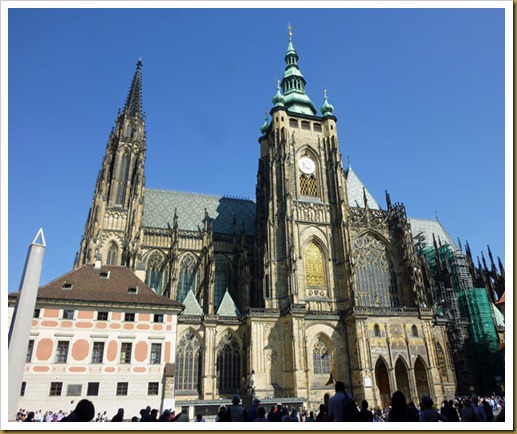 Saint Vitus' Cathedral is a Roman Catholic cathedral located within Prague Castle and contains the tombs of many Bohemian Kings and Holy Roman Emperors. This cathedral is an excellent example of Gothic architecture and is the biggest and most important church in the country. In 1929, the St. Vitus Cathedral was finally finished, 600 years after it was begun.
Saint Vitus' Cathedral is a Roman Catholic cathedral located within Prague Castle and contains the tombs of many Bohemian Kings and Holy Roman Emperors. This cathedral is an excellent example of Gothic architecture and is the biggest and most important church in the country. In 1929, the St. Vitus Cathedral was finally finished, 600 years after it was begun.
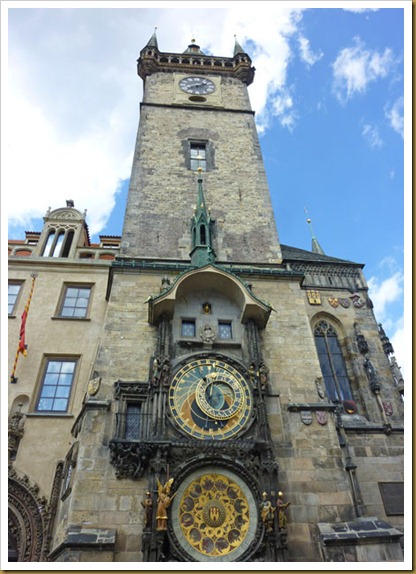 The Prague Astronomical Clock is a medieval astronomical clock first installed in 1410, making it the third-oldest astronomical clock in the world and the only one still working. The clock is mounted on the southern wall of Old Town City Hall in the Old Town Square. The clock mechanism itself is composed of three main components: the astronomical dial, representing the position of the Sun and Moon in the sky; "The Walk of the Apostles," a clockwork hourly show of figures of the Apostles and other moving sculptures, and a calendar dial with medallions representing the months
The Prague Astronomical Clock is a medieval astronomical clock first installed in 1410, making it the third-oldest astronomical clock in the world and the only one still working. The clock is mounted on the southern wall of Old Town City Hall in the Old Town Square. The clock mechanism itself is composed of three main components: the astronomical dial, representing the position of the Sun and Moon in the sky; "The Walk of the Apostles," a clockwork hourly show of figures of the Apostles and other moving sculptures, and a calendar dial with medallions representing the months
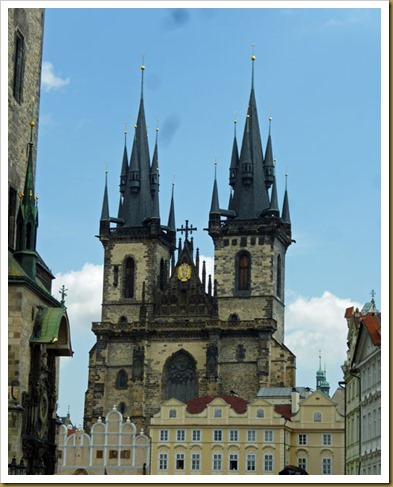 The Church of Our Lady before Týn is a dominant feature of the Old Town and has been the main church of this part of the city since the 14th century.
The Church of Our Lady before Týn is a dominant feature of the Old Town and has been the main church of this part of the city since the 14th century.
Jewish Prague
Jews are believed to have settled in Prague as early as the 10th century. The first pogrom (ethnic cleansing) was in 1096, and eventually Jews were concentrated within a walled Ghetto. Through the centuries, the Jews suffered further persecution; and between 1893 and 1913, most of the quarter was demolished. With the Nazi German occupation one could have expected the complete the demolition of the old ghetto. However, the area was preserved in order to provide a site for a planned "exotic museum of an extinct race." This meant that the Nazis gathered Jewish artifacts from all over central Europe for display in Jewish Prague..
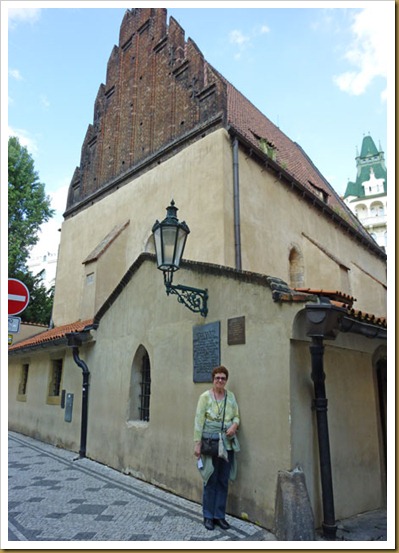 The Old-New Synagogue, built in the middle of the 13th century, is one of the oldest surviving synagogues in Europe. It is one of three active synagogues in Prague where services are still held.
The Old-New Synagogue, built in the middle of the 13th century, is one of the oldest surviving synagogues in Europe. It is one of three active synagogues in Prague where services are still held.
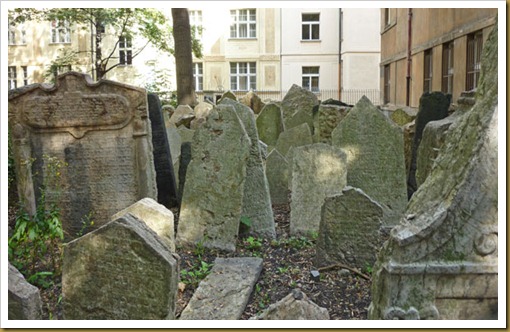 The Old Jewish Cemetery was established in the first half of the 15th century and is one of the most important surviving monuments in Jewish Prague, along with the Old-New Synagogue.Today, the cemetery contains almost 12,000 tombstones although the number of persons buried there is much greater because people were buried in layers..
The Old Jewish Cemetery was established in the first half of the 15th century and is one of the most important surviving monuments in Jewish Prague, along with the Old-New Synagogue.Today, the cemetery contains almost 12,000 tombstones although the number of persons buried there is much greater because people were buried in layers..
What a beautiful city Prague is! Around every corner was another lovely surprise. Bonnie wasn’t feeling up-to-par this morning so she didn’t join us until our afternoon tour of the Jewish Quarter. She had been to Prague before so she was familiar with the sites we saw.
